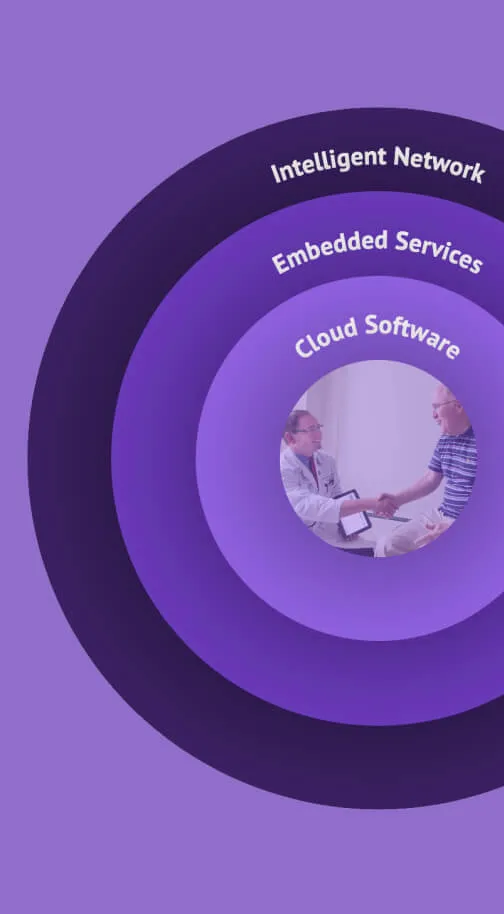Study: multiple payment models help MDs feel more financially secure

According to recent research, only 38% of physicians feel that their healthcare organization is on solid financial footing, leaving 62% of doctors feeling their practice’s financial stability is rocky.1 While startling, that number is not exactly surprising. Healthcare organizations in the US have faced numerous challenges in recent years––many supercharged by the COVID-19 pandemic—like staffing shortages, operational inefficiencies, and general physician burnout.
One indicator of this financial strain is physician pay, which has lagged behind cost increases for years. According to the American Medical Association, Medicare pay for physicians in particular has decreased by roughly 26% since 2001 when adjusted for inflation to practice costs, which have steadily risen over the same timeframe.2
Taken together, these financial challenges can become overwhelming. So much so that one recent research report found that more than 6 in 10 physicians have considered leaving the medical field altogether, with 25% citing financial/monetary concerns as the leading issue.3
While many of these challenges are daunting, some healthcare organizations are finding better financial security by diversifying the payment models they utilize. Let's take a closer look at the data, and what it says about how reimbursement models impact perceptions of financial security.
Healthcare payment models: fee-for-service and value-based care
Getting paid has long been a defining complexity for healthcare providers in the US. For many years, the primary payment model in the US has been fee-for-service, an arrangement that pays physicians based on quantities of appointments and procedures. Under this healthcare payment model, specific services and procedures are assigned a fee, and a provider is reimbursed according to the volume of work they deliver rather than the quality of the work or the outcomes experienced by patients.
This focus on volume is not inherently beneficial to patients, and some researchers have raised questions about the ethics of this common model when it comes to patient care.4 Fee-for-service is also a major factor in why the US has the worst patient outcomes of any high-income nation. Still, fee-for-service remains a cornerstone of the healthcare system in the US.5
Value-based payment models are relatively new by comparison. Value-based models aim to bring the interests and incentives of both patients and providers into better alignment by focusing on measurable health outcomes, cost-effective care, and improved patient access, rather than the volume of services and procedures performed.
There are a variety of value-based care programs for providers to participate in, both via federal and state programs as well as through private payers. As value-based care gains traction, an increasing number of healthcare organizations are incorporating value-based programs alongside their traditional fee-for-service model.
Multiple healthcare payment models lead to feeling more financially secure
A recent study by athenahealth asked physicians about their feelings of financial security. The responses varied widely depending on which payment model(s) those respondents said they used.
For example, 35% of physicians operating exclusively on a fee-for-service model feel their healthcare organization is financially secure. The percentage of those reporting financial security drops to 31% for physicians working exclusively under a value-based care model.6
However, nearly half (47%) of physicians at healthcare organizations incorporating a mix of both payment models feel that their organization is financially secure, a substantial improvement.7
It should be noted that healthcare organizations using a value-based care model exclusively are still relatively rare (roughly 10%). 42% of study participants use only fee-for-service, and 39% use both.8
The rise of value-based care models among primary care and specialties
Value-based care has steadily gained popularity in recent years. In fact, McKinsey estimates that the number of people covered under value-based care models will increase by 109% between 2022 and 2027 to roughly 90 million people.9 This evolution seems to be happening across the US healthcare landscape. Roughly 40% of primary care providers say the pandemic increased their interest in value-based payment models.10 And, McKinsey expects substantial growth in specialty value-based care models, where penetration in areas like orthopedics and nephrology could more than double in the next five years.11
This growth in popularity has provided new and more effective ways for healthcare providers to care for their patients. It has also provided a way for healthcare organizations to diversify their financial strategies and establish better financial security.
Balancing financial risk with multiple payment models
One distinguishing characteristic between fee-for-service and value-based care models is financial risk. In general, a fee-for-service approach presents lower financial risk to healthcare organizations because providers know the services they deliver will be paid for, regardless of the health outcomes of those services. While this doesn’t necessarily incentivize the most effective treatment for a patient, it can generate more predictable and consistent payments and help ensure that the costs of delivering care are more than covered by reimbursements.
Value-based care programs, on the other hand, often place a higher degree of financial risk on the provider. That’s because reimbursements are determined from various quality metrics, like clinical outcomes, preventative care measures, and patient satisfaction. These metrics are much more difficult to control, meaning the financial risk is greater.
For these reasons, it can be beneficial for healthcare organizations moving into value-based care programs to do so alongside the more traditional fee-for-service approach. Striking the right balance between fee-for-service and value-based care not only provides a more diversified financial model—it can also help healthcare organizations evolve toward more value- and quality-oriented models without taking on too much financial risk in the short-term.
Infrastructure investments to support multiple payment models
Healthcare technology is an important consideration for any healthcare organization looking to diversify payment models. Those utilizing a fee-for-service approach can attest to the complexity and administrative work required to manage documentation, coding and billing, insurance verification, revenue cycle management tasks, and more.
As complex as fee-for-service can be, administering value-based programs can be just as challenging. However, the right healthcare IT platform that includes customizable workflows, data connectivity, and other key capabilities can help support organizations looking to utilize multiple payment models.
Here are a few of the key technology capabilities that help healthcare organizations scale their operations to incorporate multiple payment models.
- Interoperability and data exchange: Patient data is central to meeting many requirements for value-based programs. A connected healthcare IT platform with robust electronic health records (EHR) capabilities can help efficiently retrieve and surface crucial data to clinicians at the right place and at the right time. Having access to this data, alongside customizable and simplified clinical workflows, is crucial for establishing efficient processes.
- Care and diagnosis gap tracking: For many value-based programs, closing care and diagnosis gaps is tied directly to reimbursements. However, those gaps are often not obvious, and can be hidden in vast quantities of data. The right healthcare IT platform will track those gaps and surface that information within a clinical workflow. Helping physicians close care gaps—and doing so efficiently and naturally during a patient encounter— adds significant efficiencies and contributes to better success in value-based programs.
- Data analytics and program tracking: Some healthcare IT platforms with EHR capabilities can help healthcare organizations succeed in value-based care programs by tracking compliance with quality program requirements, along with tracking any ongoing changes to the requirements for whatever value-based programs an organization participates in. Allowing the platform provider to take on the burden of monitoring these requirements can save lots of time, and generally help organizations be more successful in the programs they choose to participate in.
Organizations looking to diversify payment models should look for a healthcare IT platform that offers the capabilities, services, and expertise to help them be successful no matter which payment models they leverage, and how.
- 2023 Physician Sentiment Survey, commissioned by athenahealth and fielded by Harris Poll, Jan 2024
- AMA, Medicare physician pay has plummeted since 2001. Find out why. June 2024; https://www.ama-assn.org/practice-management/medicare-medicaid/medicare-physician-pay-fell-26-2001-how-did-we-get-here
- 2023 Physician Sentiment Survey, commissioned by athenahealth and fielded by Harris Poll, Jan 2024
- Riegler, J. (2023). Comparative Ethics of Modern Payment Models: Does the Way We Pay for Care Align with Patient Care Ethics? Voices in Bioethics, 9. https://doi.org/10.52214/vib.v9i.10310
- The Commonwealth Fund, U.S. Health Care from a Global Perspective, 2022: Accelerating Spending, Worsening Outcomes, Jan. 2023; https://www.commonwealthfund.org/publications/issue-briefs/2023/jan/us-health-care-global-perspective-2022
- 2023 Physician Sentiment Survey, commissioned by athenahealth and fielded by Harris Poll, Jan 2024
- Ibid
- Ibid
- McKinsey & Company, Jan 2024, What to expect in US healthcare in 2024 and beyond, https://www.mckinsey.com/industries/healthcare/our-insights/what-to-expect-in-us-healthcare-in-2024-and-beyond?stcr=FEFACC03D40F492EBD8401B5DCEEB6C3&cid=other-eml-alt-mip-mck&hlkid=2d8461c861f644cdb13cae55b6af9283&hctky=14669808&hdpid=edd3998f-a0c6-45fa-86c6-b0cd71574e4d; IS079
- Bain & Co., 2022, Primary Care 2030: Innovative Models Transform the Landscape, pg 4, https://www.bain.com/contentassets/a16de3e07c0d462e8cbf967a5fe41ec3/bain_brief_primary-care-2030.pdf; IS111
- McKinsey & Company, Jan 2024, What to expect in US healthcare in 2024 and beyond, https://www.mckinsey.com/industries/healthcare/our-insights/what-to-expect-in-us-healthcare-in-2024-and-beyond?stcr=FEFACC03D40F492EBD8401B5DCEEB6C3&cid=other-eml-alt-mip-mck&hlkid=2d8461c861f644cdb13cae55b6af9283&hctky=14669808&hdpid=edd3998f-a0c6-45fa-86c6-b0cd71574e4d; IS079











